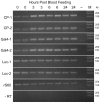Development of the bi-partite Gal4-UAS system in the African malaria mosquito, Anopheles gambiae
- PMID: 22348104
- PMCID: PMC3278442
- DOI: 10.1371/journal.pone.0031552
Development of the bi-partite Gal4-UAS system in the African malaria mosquito, Anopheles gambiae
Abstract
Functional genetic analysis in Anopheles gambiae would be greatly improved by the development of a binary expression system, which would allow the more rapid and flexible characterisation of genes influencing disease transmission, including those involved in insecticide resistance, parasite interaction, host and mate seeking behaviour. The Gal4-UAS system, widely used in Drosophila melanogaster functional genetics, has been significantly modified to achieve robust application in several different species. Towards this end, previous work generated a series of modified Gal4 constructs that were up to 20 fold more active than the native gene in An. gambiae cells. To examine the Gal4-UAS system in vivo, transgenic An. gambiae driver lines carrying a modified Gal4 gene under the control of the carboxypeptidase promoter, and responder lines carrying UAS regulated luciferase and eYFP reporter genes have been created. Crossing of the Gal4 and UAS lines resulted in progeny that expressed both reporters in the expected midgut specific pattern. Although there was minor variation in reporter gene activity between the different crosses examined, the tissue specific expression pattern was consistent regardless of the genomic location of the transgene cassettes. The results show that the modified Gal4-UAS system can be used to successfully activate expression of transgenes in a robust and tissue specific manner in Anopheles gambiae. The midgut driver and dual reporter responder constructs are the first to be developed and tested successfully in transgenic An. gambiae and provide the basis for further advancement of the system in this and other insect species.
Conflict of interest statement
Figures





Similar articles
-
Using the GAL4-UAS System for Functional Genetics in Anopheles gambiae.J Vis Exp. 2021 Apr 15;(170). doi: 10.3791/62131. J Vis Exp. 2021. PMID: 33938894
-
Optimization of the Gal4-UAS system in an Anopheles gambiae cell line.Insect Mol Biol. 2011 Oct;20(5):599-608. doi: 10.1111/j.1365-2583.2011.01090.x. Epub 2011 Jun 24. Insect Mol Biol. 2011. PMID: 21699594
-
Gal4-based enhancer-trapping in the malaria mosquito Anopheles stephensi.G3 (Bethesda). 2012 Nov;2(11):1305-15. doi: 10.1534/g3.112.003582. Epub 2012 Nov 1. G3 (Bethesda). 2012. PMID: 23173082 Free PMC article.
-
Gal4 Driver Transgenic Zebrafish: Powerful Tools to Study Developmental Biology, Organogenesis, and Neuroscience.Adv Genet. 2016;95:65-87. doi: 10.1016/bs.adgen.2016.04.002. Epub 2016 Jun 13. Adv Genet. 2016. PMID: 27503354 Review.
-
Ectopic gene expression in Drosophila using GAL4 system.Methods. 1998 Apr;14(4):367-79. doi: 10.1006/meth.1998.0592. Methods. 1998. PMID: 9608508 Review.
Cited by
-
Organization of olfactory centres in the malaria mosquito Anopheles gambiae.Nat Commun. 2016 Oct 3;7:13010. doi: 10.1038/ncomms13010. Nat Commun. 2016. PMID: 27694947 Free PMC article.
-
Isolation and transcriptomic analysis of Anopheles gambiae oenocytes enables the delineation of hydrocarbon biosynthesis.Elife. 2020 Jun 15;9:e58019. doi: 10.7554/eLife.58019. Elife. 2020. PMID: 32538778 Free PMC article.
-
Tools for Anopheles gambiae Transgenesis.G3 (Bethesda). 2015 Apr 13;5(6):1151-63. doi: 10.1534/g3.115.016808. G3 (Bethesda). 2015. PMID: 25869647 Free PMC article.
-
Regulation of the gut-specific carboxypeptidase: a study using the binary Gal4/UAS system in the mosquito Aedes aegypti.Insect Biochem Mol Biol. 2014 Nov;54:1-10. doi: 10.1016/j.ibmb.2014.08.001. Epub 2014 Aug 21. Insect Biochem Mol Biol. 2014. PMID: 25152428 Free PMC article.
-
A new suite of reporter vectors and a novel landing site survey system to study cis-regulatory elements in diverse insect species.Sci Rep. 2024 May 2;14(1):10078. doi: 10.1038/s41598-024-60432-9. Sci Rep. 2024. PMID: 38698030 Free PMC article.
References
Publication types
MeSH terms
Substances
Grants and funding
LinkOut - more resources
Full Text Sources

